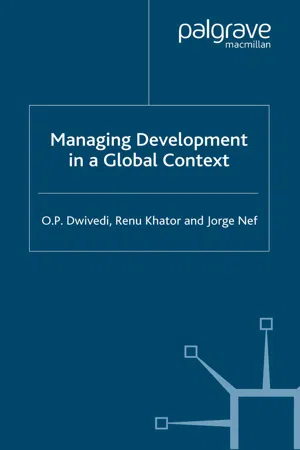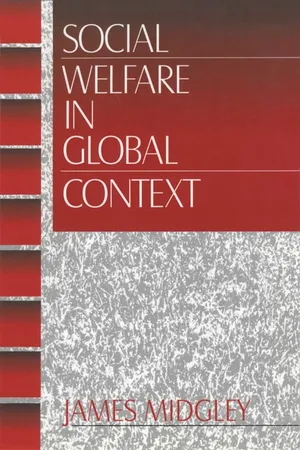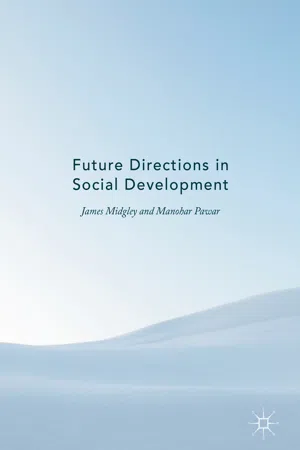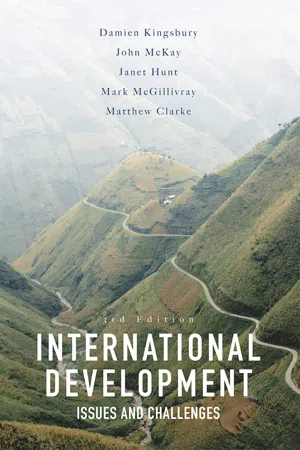Social Sciences
Global Development
Global development refers to the progress and improvement of living standards, economic opportunities, and social well-being on a worldwide scale. It encompasses efforts to reduce poverty, inequality, and environmental degradation, as well as promote sustainable development and human rights. Global development initiatives often involve collaboration between governments, international organizations, non-governmental organizations, and other stakeholders to address complex challenges facing the global community.
Written by Perlego with AI-assistance
Related key terms
1 of 5
7 Key excerpts on "Global Development"
- eBook - PDF
- O. Dwivedi, R. Khator, J. Nef(Authors)
- 2007(Publication Date)
- Palgrave Macmillan(Publisher)
We will attempt to straddle a conceptual and analytical void in a broad-ranging, though systematic, way by examin- ing the complex interrelationships between management and admin- istration, on the one hand, and development and globalization on the other. Our understanding of development goes beyond traditional defini- tions centered on spontaneity, economic growth, and the GNP. It 2 Managing Development in a Global Context encompasses a myriad of interrelated and reciprocating environmental, economic, social, and political attributes (Heady, 1979). It also relates to matrices of cultural preferences, values, and ethics. In the final analysis, we are looking at development as the spread and consolidation of the material, natural, and spiritual well-being of people and nations. For us, this well-being is not just a mere actuarial aggregation of indexes and arcane parameters. At a structural level, well-being means most people being able to live in a safe and sustainable environment, now and in future generations. It also means sharing in the material benefits of their labor, in an equitable and persistent way. It implies nurturing networks of social support and solidarity that permit living without want and anguish and experiencing positive interpersonal relations characterized by care and compassion. It also means empowerment and living freely without discrimination, violence, fear, and abuse (Prescott- Allen, 2001). Lastly, it means a set of values, practices, and cognitions that permit people to take charge of their own future and learn from error, so as to provide for environmental sustainability, equitable eco- nomic prosperity, social safety networks, peace, and enlightenment. In this sense, development is more than a matter of chance. This is where the connection between induced development and management is important, for development is essentially a historical consequence of human agency. - eBook - PDF
- James Midgley(Author)
- 1997(Publication Date)
- SAGE Publications, Inc(Publisher)
Social development not only requires that social service programs contribute positively to economic development but insists that economic development con-tribute to improvements in people's welfare. Social development advocates believe that economic growth is a prerequisite for raising standards of living. However, they claim that economic growth of itself does not automatically enhance standards of living. They do not accept that the benefits of economic growth trickle down to the masses. Instead, they insist that economic growth creates employment, increases people's incomes, and raises standards of living. It is the failure to ensure that economic growth reaches all sections of the population that is responsible for the conditions of distorted development that characterize many countries today (Midgley, 1995). The problem in many countries is not an absence of economic development but rather a failure to harmonize economic and social objectives and to ensure that the benefits of economic progress reach the population as a whole. The problem of distorted development was recognized in the description of global social conditions in Chapter 3. In addition to harmonizing economic and social interventions, social develop-ment has several other distinctive features. For example, it has an interdisciplinary focus, which draws on the knowledge of different social sciences. It is, in particu-lar, inspired by the insights of political economy that focus on economic and political issues within a broad macroframework. This macroframework reflects social development's inclusive or universalistic scope. Instead of focusing on needy individuals, social development is concerned with communities, regions, and societies. - eBook - PDF
- Gregory Hooks(Author)
- 2016(Publication Date)
- University of California Press(Publisher)
The concept of development has been defined and redefined many times in the past. At the most basic level, it refers to the Western idea of progress and growth stemming from the philosophy and scientific advances of the Enlightenment, with globalization being its latest operational version inducing much criticism. However, no matter how one defines development, it has a strong foundation in aggregate human conditions P O P U L A T I O N A N D D E V E L O P M E N T • 65 and a mutual interrelation with population dynamics. Development creates the intel-lectual framework for population studies, and demography provides pragmatic consid-erations for development theory. It is unlikely that scholars will ever agree on population and development narratives and actions as much as they did under the modernization paradigm, but no matter how context-dependent the causal mechanisms between the two may be, population and development are inseparable. And, while working on the numerous global and local challenges in that nexus, demographers and development scholars alike are responsible for keeping the discourse focused on all three of the broad issues: economic prosperity, environmental impact, and social equality. REFERENCES Allen, Garland. 1989 . “Eugenics and American Social History, 1880–1950 .” Genome 31 : 885–89 . Bauer, Peter. 1972 . Dissent on Development. Cambridge, Mass.: Harvard University Press. Beale, Calvin. 1975 . The Revival of Population Growth in Non-Metropolitan America. USDA ERS-605 . Washington, D.C.: U.S. Department of Agriculture. Becker, Gary. 1960 . “An Economic Analysis of Fertility.” In Demographic and Economic Change in Developed Countries, edited by the National Bureau for Economic Research, 209–40 . New York: Columbia University Press. . 1981 . A Treatise of the Family. Cambridge, Mass.: Harvard University Press. Birdsall, Nancy, Allen Kelley, and Steven Sinding, eds. - eBook - PDF
- David Jaffee(Author)
- 1998(Publication Date)
- Praeger(Publisher)
1 Introduction: The Meaning of Development and the Levels of Theory In any area of scholarly inquiry, there are always several ways in which the phenomena under study may be sorted and arranged... the observer may choose to focus upon the parts or upon the whole, upon the components or upon the system.... Whether he selects the micro- or macro-level of analysis is ostensibly a mere matter of methodological conceptual conven- ience. Yet the choice often turns out to be quite difficult, and may well become a central issue within the discipline concerned.... The responsible scholar must be prepared to evaluate the relative utility—conceptual and methodological—of the various alternatives open to him, and to appraise the manifold implications of the level of analysis finally selected. (Singer 1961:77) The study of socio-economic development is a truly interdisciplinary venture. Analyzing the causes and consequences of social change requires crossing the conventional boundaries of academic social science. Each field of social sci- ence—anthropology, economics, history, political science, psychology, geogra- phy, sociology—has some insight to contribute. Socio-economic change shapes, and is shaped by, individual perceptions and beliefs, cultural patterns, economic organizations, methods of production and distribution, socio-political arrange- ments, and the international economy. The process of development is broad and all-encompassing. It is difficult to discount the importance of any social pattern or institution. Explaining development is further complicated by the fact that each discipline is composed of subdisciplines, subareas, and subfields that tend to emphasize one particular slice of social reality. Social scientists tend to focus upon one or a small number of factors as the key to understanding socio-economic devel- 2 Levels of Socio-economic Development Theory opment. - eBook - PDF
- James Midgley, Manohar Pawar, James Midgley, Manohar Pawar(Authors)
- 2016(Publication Date)
- Palgrave Macmillan(Publisher)
Although social wel- fare has traditionally been promoted through income transfers and social services, social development uniquely utilizes economic growth for social ends by implementing projects that combine economic and social activi- ties, mobilizing popular participation for development and investing in individuals, families and communities. After the Second World War, social development appealed to the gov- ernments of the newly sovereign nations of the Global South that had secured independence from European imperial rule. To fulfil their strug- gle for freedom, many embraced the idea of development in order to achieve economic and social prosperity for their citizens. Supported by the international organizations and the former imperial powers, they believed that this could best be accomplished through interventions that fostered economic growth and ensured that people participate in and benefit from these interventions. Since then, a large variety of policies, programmes and projects that give expression to social development ideas have been imple- mented and although the result is an eclectic mix of interventions, the social development approach is now well established providing an agenda for enhancing peoples’ wellbeing not only in the Global South but the Western nations as well. This chapter provides an historical background to this book and hope- fully it will clarify a field that still requires academic refinement and greater practice coherence. Although the term social development has become popular, it is used loosely and its theoretical assumptions are not ade- quately articulated. By tracing social development’s historical evolution and various attempts by social development advocates to provide a con- ceptual basis for practice, debates about the future directions of social development may be better understood. - eBook - PDF
International Development
Issues and Challenges
- Damien Kingsbury, John McKay, Janet Hunt(Authors)
- 2016(Publication Date)
- Red Globe Press(Publisher)
It is just not about improvements according to a single criterion, but multiple criteria. The extent to which this had become appreciated in the early 1990s and onwards is evident in statements emanating from the World Bank. The World Bank had long (and sometimes unfairly) been seen as a vanguard of a market-friendly, economic growth-first approach to development strategy. It differentiated between what is referred to as ‘economic development’ and ‘development in a broader sense’ in its World Development Report 1991 (World Bank 1991a ). Economic development was seen as a ‘sustainable increase in living standards that encompasses material consumption, education, health and environmental protection’ (World Bank 1991a : 31). Development in the broader sense was articulated by the World Bank as follows: Development in a broader sense is understood to include other important and related attributes as well, notably more equality of opportunity, and political and civil liberties. The overall goal of development is therefore to increase the economic, political, and civil rights of all people across gender, ethnic groups, religions, races, regions and countries. (World Bank 1991a : 31) The pendulum had firmly swung, it seems. What is Development? 37 The World Bank, in these quotes, refers to the various population sub-groups (delineated by gender, ethnicity and so on), sustainability and the environment. These issues have for a number of years been highly relevant to development theory and the definition of develop-ment. Let’s deal with each in turn. Inequality of incomes among people within countries was discussed above. This type of inequality is often referred to as ‘vertical inequal-ity’ in that it refers to differences in incomes between individuals. Horizontal inequality refers to the existence of inequalities between groups of individuals, typically within countries. - Emelyn Cereno Wagan(Author)
- 2019(Publication Date)
- Society Publishing(Publisher)
Skill Development in a Global Context 4 CONTENTS 4.1. Introduction ...................................................................................... 90 4.2. Defining Life Skills ............................................................................ 93 4.3. The Development Of Life Skills: From Evolution To Its Advancement ................................................................................. 94 4.4. Current Engagement And Support For The Global And International Agenda ............................................................. 100 4.5. Help And Support For The Students ................................................. 102 4.6. The Global Dimension Within The Colleges And Other Training Providers ............................................................... 104 4.7. Impact Of Global Forces And The Current Economic Situation On The Activities Of Providers ....................................... 106 4.8. Skills For A Global Economy ........................................................... 108 4.9. Personal, Social, And Cultural Development of The Learner ............ 110 4.10. The College And The Community .................................................. 115 References ............................................................................................. 117 Skill Development and Sustainable Educational Growth 90 Skill development is a method of learning which questions dominant paradigms of development and motivates the citizen- and community-driven change towards a world of greater social justice. This chapter provides an overview of skill development and reflects on the degree to which skill development principles are presently reflected in, mainstream educational and skill development policies followed within an international development framework.
Index pages curate the most relevant extracts from our library of academic textbooks. They’ve been created using an in-house natural language model (NLM), each adding context and meaning to key research topics.






